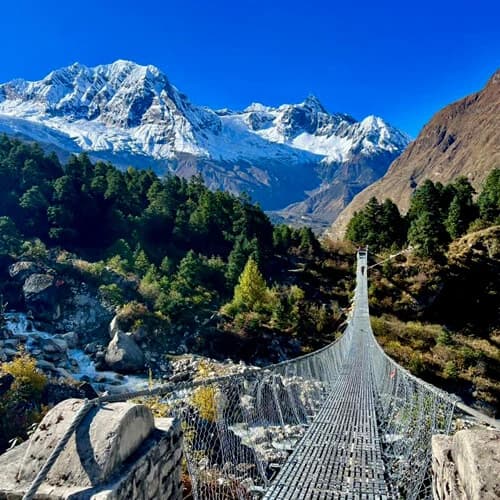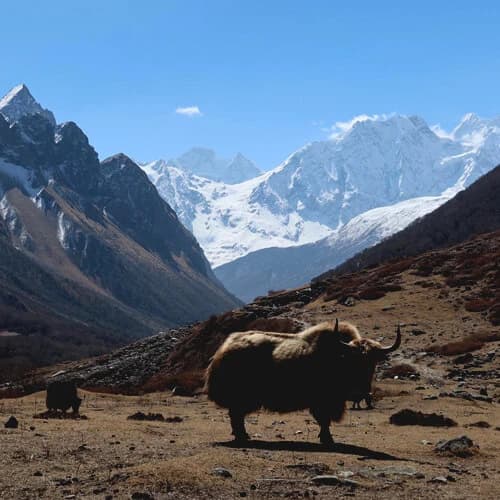"Do you want to begin the Manaslu Circuit but not sure if it's suitable for a first-time trekker? The answer may surprise you because you may be a better fit for it than you realize. With careful preparation, a guided itinerary, and good fitness levels, beginners can successfully tackle the Manaslu Circuit and experience its pristine natural beauty. This comprehensive guide provides all the key information like altitude, trail challenges, permits, equipment, and acclimatization tips to help you confidently plan your journey through this less-traveled Himalayan route."
Can a Beginner Trek to Manaslu Circuit
Is the Manaslu Circuit Suitable for Beginners?
Yes, the Manaslu Trekking is suitable for beginners who are physically fit and mentally prepared. This trek is considered moderate in difficulty and doesn't involve exposure to high-altitude terrains or adverse weather conditions, making it achievable for first-time trekkers. The trail reaches its highest point at Larkya La Pass, 5,106 meters above sea level, where altitude sickness becomes a genuine concern. However, with proper acclimatization, a slow and steady pace, and sufficient hydration, many beginners have successfully completed the trek.
The Manaslu Circuit is beginner-friendly because the routes are well-marked and accompanied by several infrastructure points along the trail, providing comfortable food and lodging. Additionally, our Manasu Circuit is designed meticulously with strategic stops for acclimation. The slow and gradual adaptation of increasing elevation enables your body to function at high altitudes with low oxygen levels. Also, it is crucial for beginners to prepare themself with the proper physical training to enhance their physical capability. We recommend focusing on developing your core areas, such as stamina, leg strength, core muscles, and muscle flexibility.
Having said that, the Manaslu Circuit trek offers an outstanding balance of adventure and accessibility. It is an ideal choice for beginners ready to train, acclimatize properly, and embrace the Himalayan experience. We recommend hiring a licensed guide for an enhanced travel experience. They will be responsible for your safety and assist you in the navigation of the trails, especially at tricky sections. You can report any dissatisfaction or issues with the service during the trek. Our experienced staff members will dedicate themselves to ensuring the beginning of your Himalayan journey is a memorable one.
Key Considerations for Beginners:
Building your fitness:
This trek demands solid endurance and cardiovascular health. Beginners are encouraged to start preparing months in advance with regular hikes, cardio workouts, and strength training to build stamina and overall fitness.
Altitude sickness and how to avoid:
Since the route reaches high altitudes, adjusting gradually is vital to avoid altitude sickness. Taking rest days at key elevations, ascending slowly, and staying well-hydrated are essential parts of the process.
Guide and potter:
For those new to trekking, hiring a guide and porter can improve the experience. A guide offers navigation support, local knowledge, and logistical help, while a porter can ease the load by carrying your heavier gear.
Prepare and pack smart:
Learn about the trail, understand what to expect, and pack wisely. Must-have items include a reliable backpack, a sleeping bag, waterproof layers, trekking poles, and clothing suitable for varying weather conditions.
Mental preparation:
This trek can be as mentally demanding as it is physically challenging. Be prepared for long trekking days, limited comforts, and unpredictable conditions. A flexible and resilient mindset will help you push through the more challenging moments.
Steady pace:
Taking it slow isn't just safer; it's more rewarding. Maintain a steady pace that allows your body to adjust naturally, and take time to appreciate the scenery and the experience as it unfolds.
What Is the Manaslu Circuit Trek and Why Is It Popular?
The Manaslu Circuit Trek is a renowned high-altitude trekking route in Nepal that circles Mount Manaslu (8,163 meters), the eighth-highest mountain in the world. The journey is known for its stunning scenery, cultural depth, and quieter trails; it's often praised as one of Nepal's most rewarding treks. Spanning approximately 177 kilometers, the circuit takes 14 to 23 days to complete, depending on the chosen package and itinerary.
One of the main reasons for its popularity is the perfect mix of raw natural beauty and authentic cultural experiences. Unlike the busier Everest or Annapurna regions, Manaslu remains relatively untouched, offering a more peaceful and immersive journey. Trekkers pass through traditional villages influenced by Tibetan Buddhism, ancient monasteries, mani walls, and chortens. The trail's highest point is at Larkya La Pass (5,160 meters), offering breathtaking views of the Himalayan peaks.
The Manaslu Circuit stands out for its blend of remote wilderness, cultural authenticity, and stunning mountain views. Its quieter trails are challenging yet rewarding, with deep cultural immersion, making it a top choice for trekkers seeking a less commercialized Himalayan experience. With proper preparation and permits, it offers an unforgettable adventure far from the mainstream routes.
How Long Does it Take for Beginners to Complete the Manaslu Circuit Trek?
For beginners, the Manaslu Circuit Trek typically takes around 14 days to complete. Our well-paced itinerary is designed to allow gradual acclimatization and manageable trekking distances, making it suitable for those new to high-altitude trekking. The journey begins with your arrival in Kathmandu and a scenic drive to Soti Khola, where the trek officially starts.
Over the next several days, you'll pass through a variety of landscapes, from low river valleys and terraced hillsides to high alpine zones. The route ascends gradually, passing through key villages such as Jagat, Deng, Namrung, and Sama Gaon. A full acclimatization day at Sama Gaon helps your body adjust to the thinning air, which is crucial for beginners.
The trek's highest point is the Larke La Pass at 5,135 meters, which is crossed on day eleven. After this, the trail descends through beautiful forests and meadows to Dharapani before returning to Kathmandu. With its balanced itinerary, the Manaslu Circuit offers a challenging yet achievable adventure for fit beginners ready to explore Nepal's remote mountain wilderness. The itinerary is flexible and can be customized with additional rest days or side trips for those seeking extra adventure or acclimatization.
14 Days Manaslu Circuit Trek Route Itinerary
The most suitable Manaslu Circuit route for beginners is the classic 14-day itinerary, which starts from Soti Khola and ends in Dharapani. It offers a well-paced journey through remote villages like Jagat and Samdo, with proper acclimatization at Sama Gaon before crossing the high Larke La Pass (5,135m).
This route is ideal for trekkers with good fitness, providing gradual altitude gain and rich cultural experiences. Compared to shorter or rushed versions, this itinerary minimizes altitude risk while showcasing the best of the Manaslu region in a safe and scenic way.
Day 01: Arrival at Kathmandu airport and transfer to Hotel (1345m)
Day 02: Drive from Kathmandu to Soti Khola via Arughat (700m)/ 126 km/ 8–10 hrs
Day 03: Trek from Soti Khola to Machha Khola (870m)/ 14 km/ 6–7 hrs
Day 04: Trek from Machha Khola to Jagat (1340m)/ 15 km/ 6–7 hrs
Day 05: Trek from Jagat to Deng (1860m)/ 20 km/ 6–7 hrs
Day 06: Trek from Deng to Namrung (2900m)/ 19 km/ 6–7 hrs
Day 07: Trek from Namrung to Sama Gaon (3390m)/ 17 km/ 6–7 hrs
Day 08: Acclimatization at Sama Gaon (3390m)
Day 09: Trek from Sama Gaon to Samdo (3690m)/ 8 km/ 3–4 hrs
Day 10: Trekking from Samdo to Larke La Phedi (4460m)/ 8 km/ 3–4 hrs
Day 11: Larke La Phedi to Bimthang via Larke La Pass to (5135m)/ 24 km/ 8–10 hrs
Day 12: Bimthang to Dharapani (1960m)/ 22 km/ 6–7 hrs
Day 13: Drive from Dharapani to Kathmandu (1345m)/ 118 km/ 8–9 hrs
Day 14: Departure from Kathmandu
What Is the Best Time of Year to Trek the Manaslu Circuit?
When it comes to trekking the Manaslu Circuit, timing is everything. With its high passes and remote trails, choosing the right season ensures better weather, safer conditions, and the most breathtaking views.
The region takes a dramatic shift throughout the year, from clear skies in autumn to heavy snowfall in winter. It's essential to understand the trail condition, scenery, and safety in order to make the most out of your journey.
- Spring (March, April, May): Spring is an excellent time for the Manaslu Circuit, offering warmer temperatures and stunning natural beauty. Daytime temperatures range from 12°C to 22°C in lower areas, with nighttime lows around -4°C at higher elevations. The trail is in excellent condition while being mostly dry and stable as the snow begins to melt after winter. One of the biggest highlights of spring is the blooming rhododendron forests that paint the hillsides. The visibility is also quite good, giving trekkers a clear view of the towering peaks, and wildlife sightings are more frequent in this season, adding to the richness of the trek.
- Autumn (September, October, November): Autumn is also considered the best season to trek the Manaslu Circuit. During this time of year, the weather is stable, the skies are crystal clear, and the views of snowcapped peaks, such as Manaslu, Himlung, and Ganesh Himal, are at their sharpest. Daytime temperatures range from 10°C to 20°C at lower altitudes and drop to -6°C near Larke La Pass. Trails are dry and well-defined, making trekking safer and more comfortable. This season also offers vibrant cultural experiences as local festivals like Dashain and Tihar are celebrated. With lush greenery in the lower regions and golden alpine meadows higher up, autumn provides the perfect blend of beauty and adventure.
What Gear Should Beginner Pack for the Manaslu Circuit?
The Manaslu Circuit Trek requires careful planning, particularly due to its remote location, high altitudes, and variable weather conditions. Unlike more commercial trails, you won't find much infrastructure along the route, so you will have to be self-sustainable with what you have. From cold mountain passes to warmer lowlands, you'll experience a wide range of climates in just a couple of weeks. To stay comfortable, safe, and well-prepared, it's important to pack smart and light without missing the essentials. This detailed packing list covers everything you need, from clothing and trekking gear to hygiene items and useful extras.
Head and face:
- Warm fleece or wool beanie (for cold nights and mornings)
- Sun hat or wide-brim cap (for sun protection at lower altitudes)
- Buff or neck gaiter (functional for dust, sun, or warmth)
- Polarized sunglasses with UV protection (category 3 or 4 recommended)
- Headlamp with extra batteries (essential for early starts or power outages)
- Lightweight balaclava or face mask (optional for higher altitudes)
Upper body:
- Moisture-wicking base layer tops (synthetic or merino wool)
- Insulating mid-layers (fleece jacket, light down/synthetic jacket)
- Heavy down jacket (for high altitude and cold nights)
- Trekking shirts (quick-dry, long sleeve preferred for sun protection)
- Waterproof and windproof hard shell jacket (Gore-Tex or similar)
- Lightweight, soft shell jacket (optional for flexible layering)
- Undergarments (moisture-wicking and supportive)
Lower body:
- Trekking pants (lightweight, thicker, or convertible)
- Waterproof hiking pants or rain pants
- Base layer bottoms (merino or synthetic for cold nights)
- Thermal fleece pants (for evening warmth)
- Comfortable shorts or lightweight pants (for warmer days or teahouse lounging)
Feet:
- Sturdy, broken-in trekking boots (waterproof, with good ankle support)
- Camp shoes or sandals (for evenings in lodges)
- Trekking socks (merino wool recommended)
- Thick thermal socks (for cold nights and high passes)
- Optional: gaiters (for snow, mud, or rocky terrain)
Trekking gear and accessories:
- Daypack (20–30L with rain cover for snacks, water, and daily essentials)
- Duffel bag (carried by porter; 60–80L, waterproof or with rain cover)
- Trekking poles (collapsible, lightweight, strongly recommended)
- Sleeping bag (rated to -10°C to -15°C)
- Sleeping bag liner (adds warmth and improves hygiene)
- Reusable water bottles or hydration bladder (2–3L capacity total)
- Water purification method (filter, SteriPEN, or purification tablets)
- Snacks (energy bars, trail mix, electrolytes, etc.)
- Pack rain cover or liner
- Dry bags or compression sacks (for clothing and gear organization)
Toiletries and hygiene:
- Biodegradable soap and shampoo
- Toothbrush and travel-size toothpaste
- Quick-dry towel
- Baby wipes
- Hand sanitizer
- Lip balm with SPF
- Sunscreen
- Toilet paper
- A small bottle of moisturizer
- Feminine hygiene products
- Nail clippers, tweezers, and a small mirror (optional)
First aid and medications:
- Personal medications (with backup supply)
- Diamox (for altitude sickness, consult your doctor first)
- Ibuprofen or paracetamol (for pain and headaches)
- Rehydration salts or electrolyte tablets
- Band-aids, moleskin, or blister pads
- Antiseptic cream
- Imodium (anti-diarrheal) and laxatives (just in case)
- Antibiotics (prescribed for GI or respiratory infections)
- Small first aid kit (lightweight and personalized)
Documents and essentials:
- Valid passport (with at least 6 months validity)
- Copies of passport, permits, insurance
- Travel insurance (must include high-altitude trekking and emergency evacuation)
- Cash (Nepali rupees)
- Guidebook or offline maps (Maps.me, Gaia GPS, or paper maps)
Extras and optional items:
- Power bank (10,000–20,000 mAh)
- Charging cables and adapter
- Lightweight journal or notebook
- Book or Kindle (for rest days or teahouse evenings)
- Small games or cards (great for social evenings)
- Earplugs
- Lightweight camera or GoPro (optional, but great for memories)
- Buff or bandana (for sun, wind, or dust)
Altitude Sickness on Manaslu Circuit: What Beginners Must Know
Altitude sickness is one of the challenging aspects of the Manaslu Circuit, especially for first-time trekkers. The route reaches a maximum elevation of 5,135 meters at Larkya La Pass, where oxygen levels are significantly lower. Without proper preparation, beginners may experience symptoms such as headaches, nausea, or dizziness.
Understanding how your body reacts to altitude and taking preventive steps can make all the difference. With the right approach, even high altitudes on Manaslu can be safely and confidently managed. Essential altitude tips for beginners on Manaslu are:
- Maintain a gradual pace and avoid rushing, especially after you reach an elevation above 3,000 meters.
- Include acclimatization days, so plan at least one rest day for adapting before the high pass.
- Stay hydrated and drink at least 3–4 liters of water daily to help your body adjust to altitude changes.
- Avoid alcohol and sleeping pills; it can interfere with breathing and worsen altitude symptoms during the night.
- If you feel persistent headaches, dizziness, or breathlessness, inform your guide and descend immediately.
- Consume more calories by maintaining a healthy diet that includes carbohydrate-rich foods and beverages. This will help maintain your energy level and burn energy efficiently.
Permits Required for Manaslu Trek: Beginner’s Checklist
Before embarking on your Manaslu Circuit adventure, it's essential to obtain the necessary permits. As the region falls under a restricted area and conservation zone, trekkers need multiple permits, each serving a specific purpose.
Missing any of these can lead to denied entry at checkpoints. For beginners, understanding what documents are required, how much they cost, and where to obtain them will ensure a hassle-free and legally compliant trekking experience in the Manaslu region.
- The Manaslu Restricted Area Permit, or MRAP, is the primary document required to trek through the restricted sections of the route. If you're trekking during the high season from September to November, this permit costs 100 USD for the first 7 days and 15 USD for each additional day. During the off-season, from December to August, the cost is 75 USD for the first 7 days and 10 USD per day thereafter. You cannot obtain this permit independently; it must be arranged through a registered trekking agency in Nepal, and it's only issued if you're traveling in a group of at least two people with a licensed trekking guide. Solo trekkers will need to join a group organized by an agency.
- The Manaslu Conservation Area Permit, or MCAP, is required for all individuals entering the conservation zone, which protects the biodiversity and local communities in the region. It costs 23 USD and can be picked up at the Nepal Tourism Board offices in either Kathmandu or Pokhara. This permit contributes to preserving the natural environment, helping fund trail maintenance, conservation efforts, and community development in the area. It's a one-time fee, valid for the entire trek within the Manaslu Conservation Area.
- The Annapurna Conservation Area Permit, or ACAP, is another essential permit needed as the Manaslu Circuit ends by joining the Annapurna Circuit trail at Dharapani. Since this area falls within the Annapurna region, the same conservation rules apply as those outlined in the MCAP. The ACAP also costs 23 USD per person and is available from the Nepal Tourism Board in Kathmandu or Pokhara. Even though it's only required for the last days of your trek, you must secure it before starting the trip, as checkpoints won't allow you through without it.
Tips to Mentally and Physically Prepare for the Manaslu Trek
Trekking the Manaslu Circuit is an unforgettable experience, but it's also one of Nepal's more demanding trails. Due to the high altitudes, rugged terrain, and long walking days, being prepared both mentally and physically is crucial, especially for first-time hikers. The better you train and understand the journey ahead, the more enjoyable (and safer) your trek will be. Below are practical, beginner-friendly tips that will help you build endurance, sharpen your mindset, and boost your confidence before setting foot on the trail.
- Begin preparing at least 2 to 3 months before your trek. Focus on building endurance with a combination of regular hikes, cardio workouts such as jogging or cycling, and bodyweight strength training. This will help condition your muscles and lungs for the demands of the trail.
- Jogging with a backpack (5–8 kg) will simulate the condition of the trek and build up the strength of your upper and back muscles.
- Since much of the Manaslu route involves rocky paths, steep climbs, and narrow ridges, it's a good idea to hike on local trails that mimic those conditions. Find hilly parks, forest trails, or even stairs, anything that challenges your balance and leg strength.
- Develop mental resilience by preparing for cold mornings, tired legs, changing weather conditions, and limited comforts. Remind yourself that every tough stretch is part of the adventure.
- Many beginners make the mistake of rushing early on. Instead, train yourself to walk slowly and consistently; this not only helps with stamina but also gives your body more time to adjust to altitude changes along the way.
- To simulate the actual rhythm of the trek, try hiking or walking long distances for two or three consecutive days. This builds your stamina and teaches your body how to recover overnight, just like you'll need to do on the trail.
- Altitude can make oxygen intake harder, especially above 3,000 meters. Practice breathing exercises like deep belly breathing or pranayama, which can increase lung capacity and improve oxygen efficiency, making it easier to cope with thinner air.
- Staying properly fueled and hydrated is part of trekking success. Make it a habit to drink plenty of water and eat balanced meals while you train. It helps with recovery and builds the energy habits you’ll need while hiking in remote areas.
- New boots or a stiff backpack can quickly ruin a great trek. Train in the same gear you'll wear on the trail, including socks, boots, base layers, and your daypack, so you can identify any discomfort and fix it in advance.
- Spend time learning about daily elevations, possible weather shifts, and accommodation types. Knowing what to expect helps reduce anxiety, builds confidence, and allows you to handle challenging situations more calmly.
Final Verdict: Can You Trek the Manaslu Circuit as a Beginner?
The Manaslu Circuit trek is suitable for first-timers or individuals with no prior experience, provided they are well-prepared and committed. The route is physically demanding, reaching altitudes over 5,000 meters, and requires multi-day stamina. However, with proper training, gradual acclimatization, and the guidance of an experienced expert, it's within reach.
Planning ahead, listening to your body, and maintaining a steady pace are key to staying safe and enjoying the journey. For those willing to train and embrace the challenge, this trek offers an unforgettable blend of Himalayan beauty and cultural depth.
It's a challenging trail, but with the right mindset and preparation, beginners can successfully trek the Manaslu Circuit. The sense of achievement at the end, standing beneath snow-capped peaks and walking through remote mountain villages, makes every step worth it. For many, it becomes a life-changing journey.
Is the Manaslu Circuit Trek suitable for beginners?
Yes, beginners can successfully complete the Manaslu Circuit Trek with the proper physical preparation, gradual acclimatization, and the support of a licensed guide throughout the journey.
What makes the Manaslu Circuit Trek Nepal unique?
The Manaslu Circuit Trek in Nepal is renowned for its remote trails, cultural richness, low crowds, and close-up views of Mount Manaslu, the eighth-highest peak in the world.
How long is the Manaslu Circuit Trek itinerary?
A Manaslu Circuit Trek itinerary lasts 14 to 18 days, depending on side trips, acclimatization days, and trekker pace.
How hard is the Manaslu Circuit Trek difficulty compared to Annapurna or Everest?
The Manaslu Circuit Trek is considered moderate to challenging in terms of difficulty level. It involves steep climbs, high altitudes (over 5,000m), and remote trails, making it more challenging than many standard routes.
Do I need a Manaslu Circuit Trek guide?
Yes, hiring a licensed guide is mandatory, as the route passes through restricted areas that require special permits issued only via registered agencies.
Is the Manaslu Circuit Trek solo allowed?
No, solo traveling to the Manaslu Circuit Trek is not allowed because it's a restricted area. Nepal's regulations require at least two trekkers to be accompanied by a licensed guide through a registered agency.
How high is the Larkya La Pass on the Manaslu Circuit Trek?
Larkya La Pass, which is also the highest point on the trek, stands at 5,106 meters (16,752 feet).
Is the Manaslu Circuit Trek crowded like Everest or Annapurna?
No, the Manaslu Circuit Trek is significantly less crowded than the Everest or Annapurna treks. Its restricted status and remote location keep the number of trekkers relatively low throughout the year.



